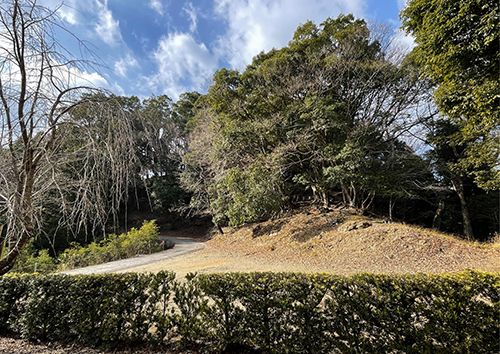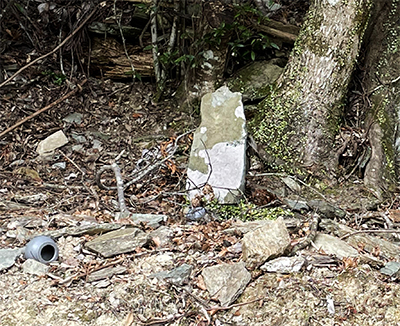


阿波の忌部氏というのは古代氏族。このブログ連載で記述中の「三木家住宅」はその後裔家系。この古代氏族・忌部氏はのちの藤原氏である中臣氏とともに朝廷の祭祀を司る氏族とされる。本願の地は大和国・橿原とされるが、朝廷に献上する麻の生産を司っていたのが阿波国の在地の同氏族。令和の天皇即位の大嘗祭に際してこの三木家が中核になって、麁服(あらたえ)を献上したことで一般に広く知られるようになった。古代氏族の忌部氏は阿波国で衣類生産を重要な役務として朝廷に奉仕してきた歴史。
現代生活で言えば「限界集落」とでも思われるような徳島県の山間部高地に居を構えて、そのような古代的な役務の家系伝統を持っていることを知った次第。わたしと同姓ということで興味を持ってたまたまの訪問機会で知ったのだけれど、知るほどに奥底の深さに驚かされる。現地に行って見て、非常にスピリチュアルと感じていたのには、空中高地の麻畑が鳥居まで立てて神聖視してあることに驚かされたこともあるけれど、その先には三木山の山頂部があり、そこに古代忌部氏・三木家の墓域が広がっていたのを見たことが大きかった。
上の写真は三木家住宅から奥の山頂部への眺望、生け垣から墓域を見た光景。そして導かれるようにたどりついたお墓群の様子。朝廷に献上する麻を一族の神聖な役務としてそれこそ身命と家系のすべてを掛けて保守し、連綿と伝承してきたその迫力に気圧されてしまった。


墓域にはたくさんの石標があるが、さらには基壇石だけになったものも多数あって、よく見るとその前には御神酒を供えたとおぼしき陶器片も散在している。三木家のはるかなご先祖のみなさんの生き様がそこに脈々とあるように思われて、思わず合掌させられておりました。
わたし自身、たまたま千葉県南端の館山を最近訪れたことがあるのですが、そこで参拝した「安房神社」はこの阿波国から古代に忌部氏が東遷した、そのことを証すものだとされている。なぜかまるで導かれているような因縁を深く感じさせられた。まことにスピリチュアル。奇妙な偶然に驚いている次第。
日本史での大成功氏族、中臣氏・藤原氏と朝廷祭祀という分野で競合関係にあったことから、歴史の表舞台からは後退していったとされるけれど、日本の古代史探究においてはきわめて重要な痕跡を残している。これは行きがかり上もう少し詳細に調べてみたいと思っている。
衣食住というように人間生活の基本が語られるけれど、衣、それも天皇に献上するものを司っていた氏族についての具体的なふれあいというのも得がたい体験。それもなぜか北海道からたまたま訪問して遭遇するというのも非常に運命的かなと。まことに迷宮に突き落とされたような気分(笑)。現地では住宅内部は見られなかったけれど資料のPDFは入手できたので、明日以降、住宅についても探究してみたい。
English version⬇
Remnants of Ancient Clan “Imobe Clan” Prayer: The Miki Family Residence, Tokushima-3
The graveyard where the family’s ancestors are buried is spread out on the mountain, and many grave markers and traces are scattered around. The power of the graves is overwhelming. The power of the site is overwhelming.
The Imobe clan of Awa is an ancient clan. The “Miki Family Residence” described in this blog series is a descendant of this family. This ancient clan, the Imobe, along with the Nakatomi clan, which later became the Fujiwara clan, is said to have been the clan in charge of rituals at the Imperial Court. Although the site of the main temple is said to be Kashihara in Yamato Province, the same local clan in Awa Province was in charge of the production of hemp to be presented to the Imperial Court. The Miki family played a central role in the ceremonial offering of hemp to the Emperor at the time of his accession to the throne in 2022, and this became widely known to the general public. The history of the Imobe clan, an ancient clan, is that they served the Imperial Court by producing clothing as an important service in Awa Province.
I learned that the Imobe clan has a family tradition of such ancient services in the mountainous highlands of Tokushima Prefecture, which would be considered a “marginal settlement” in modern life. I was interested in learning about them because they share my family name, but the more I learned about them, the more I was surprised at the depth of their family traditions. I was surprised to see that a hemp field in the highlands was considered sacred, with even a torii gate built in the middle of the field.
The photo above shows the view from the Miki family residence to the summit of the mountain, looking through the hedge toward the grave site. And this is the view of the graves that we were led to. I was overwhelmed by the power of the hemp, which was offered to the Imperial Court as a sacred family service, and which the Miki family had maintained and passed down from generation to generation, risking their own lives and those of their family members to maintain the hemp.
There are many stone markers in the graveyard, but there are also many that are only base stones, and if you look closely, you can see pieces of pottery that appear to have been used to offer sacred wine in front of them. It seemed as if the lives of the Miki family’s distant ancestors were still alive there, and I could not help but feel my hands clasped together in prayer.
I happened to visit Tateyama, located at the southern tip of Chiba Prefecture, recently, and visited the Awa Shrine, which is said to be a proof that the Imobe clan moved eastward from this Awa province in ancient times. For some reason, I felt a deep sense of causality, as if I was being guided. It was truly spiritual. I was surprised by the strange coincidence.
Although it is said that the Nakatomi and Fujiwara clans, the most successful clans in Japanese history, were in competition with each other in the field of imperial court rituals, and thus fell back from the center stage of history, they have left behind extremely important traces in the exploration of ancient Japanese history. However, they have left behind traces that are extremely important in the study of Japan’s ancient history.
The basics of human life, such as food, clothing, and shelter, are discussed, but it was also a rare experience to have a concrete contact with a clan that was in charge of clothing, especially that which was presented to the emperor. It is also a very fateful that I happened to visit from Hokkaido and encountered them. I felt as if I had been plunged into a labyrinth (laugh). I was not able to see the inside of the house, but I was able to obtain a PDF of the documents, so I would like to explore the house from tomorrow onward.
Posted on 1月 27th, 2023 by 三木 奎吾
Filed under: 日本社会・文化研究, 歴史探訪







コメントを投稿
「※誹謗中傷や、悪意のある書き込み、営利目的などのコメントを防ぐために、投稿された全てのコメントは一時的に保留されますのでご了承ください。」
You must be logged in to post a comment.